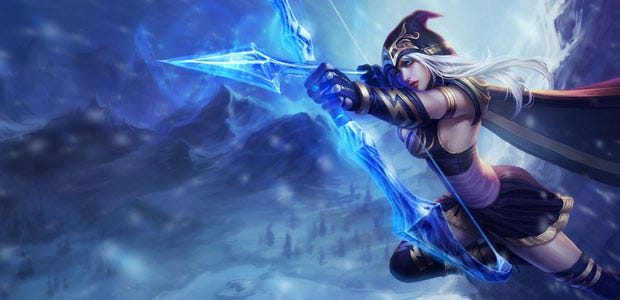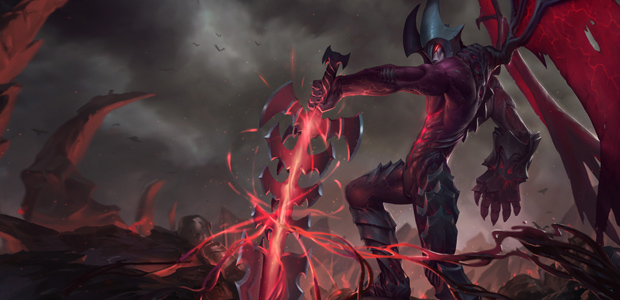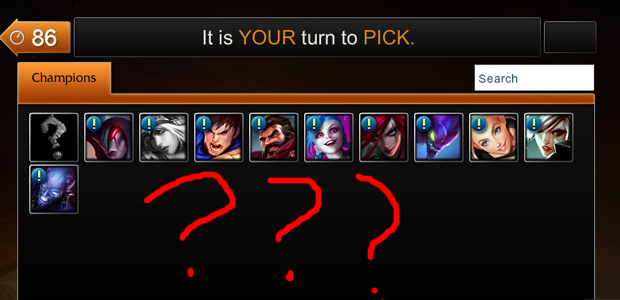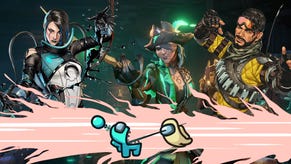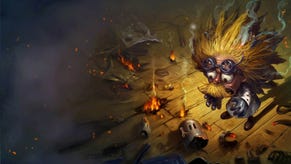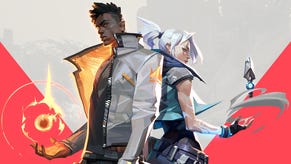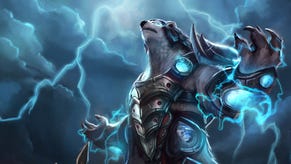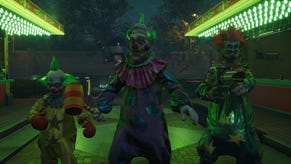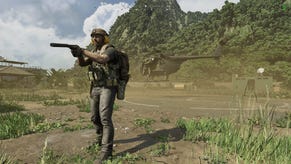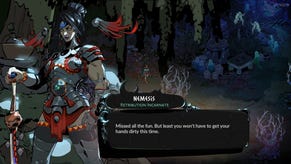Dote Night: How League Of Legends' Starter Champs Work
Learning to LoL
Part of a miscellany of serious thoughts, animal gifs, and anecdotage from the realm of MOBAs/hero brawlers/lane-pushers/ARTS/tactical wizard-em-ups. One day Pip might even tell you the story of how she bumped into Na’Vi’s Dendi at a dessert buffet cart. THIS WEEK, however, she will be finding out how League of Legends picked out their starter champion lineup!
League of Legends [official site] treats newcomers ever so slightly differently to veterans when it come to which champions they are allowed to play for their first few games. Instead of just plunging these baby Leaguers into whatever's on the free rotation you get to pick from a pre-selected roster of more straightforward characters like Ashe and Aatrox. If you're more familiar with Dota 2, it's similar to that game's Limited Hero pool. The idea is to give players a bit of guidance and prime them for a more positive introductory experience to League than if they pick a character like Orianna and proceed to get utterly destroyed. I got in touch with Riot to find out how their picked their champs:
"The starter hero lineup was one of the first things we worked on when we took a look at onboarding," says Kacee Granke - associate product manager at Riot. "We did an experiment to test the many assumptions we had about champion learnability by specially selecting ten champions for one week of our free to play rotation, based on internal assumptions about what made a champion “hard” (Vayne, Fiora) or “easy” (Sivir, Annie) for new players."
The team's suspicions were borne out in these tests: "Some of our 'high skill' champs being chosen during a player’s first game resulted in faster departure from the game after a frustrating match where they had an abysmal KDA [kill/death/assist] against our easiest opponents, Beginner Bots."
That was enough for the team to decide to work the idea up into a full feature, but the skill requirement of a character was only one factor in what made a champion a good fit for new players.
"Like most League players, we were initially biased towards thinking that complexity was the only important component in choosing a 'good' champion for new players. We asked a few other important questions that turned out to be quite relevant, though hard to quantify - what about champion fantasy, role, or aesthetics? How important were these for a new player deciding whether or not they thought the game was fun?"
When the feature went live the team was able to experiment with different line-ups in order to try and dig into how important these different aspects actually were. Here's Granke on what they found out:
- "Most surprisingly - and importantly - mechanical complexity is not the important factor. What matters is mechanical approachability – can I do good enough with this character with very little or no experience against bots or people of similar skill? Can I get a kill by pressing buttons, even if I’m not executing at the optimal level (or even close to it)? Lissandra and Varus are good examples of champions that surprised us by being really great new player champions, and we realized that you can be successful with them (ie, do lots of damage, kill things) even though you might be unaware of the champion’s intricacies or high-level play."
- "Ranged champions are almost universally easier for a first time player. Managing minion aggro and early-game damage turned out to be one of the most difficult things to teach gamers. Ranged characters force you to stand back and dish out damage from the back line instead of getting up-close and personal, which results in fewer deaths and more kicking (bot) ass. Ranged AD carries in particular fared very well for those reasons and also that their basic attacks dish out the majority of their damage, which is great for players still learning how to use abilities."
- "Early champion choices tend to be sticky, and aesthetic definitely comes into play. For players who went through the tutorial and played Ashe, Ashe would often be their #1 choice going forward. For players who hadn't gone through the tutorial, new players would pick based on their personal affinity for certain archetypes of characters - or at least who looked like they could dish out the most damage (bigger sword = more damage, obviously)."
- "Support champions had a pretty abysmal retention rate to begin with, but we thought they were important to offer and introduce to new players. Eventually we realized that it was what items we recommended to new players on support champions, not the champions themselves, were what was holding us back, and were able to make changes in Intro Bots that made support champions fun and accessible for new players."
"Over several weeks, we adjusted the champions in the roster based on these observations which helped us turn this feature into something that made a real positive impact on the new player experience - improving KDAs against bots, reducing leaver rates, and ultimately increasing retention."
The current roster of starter champions is as follows:
- Aatrox
- Ashe
- Garen
- Graves
- Jinx
- Katarina
- Kha'Zix
- Lux
- Riven
- Ryze
One of the interesting things to me – and, Granke says, the biggest lesson for the team – is that what an experienced player thinks will be easy or hard for a new player is pretty wide of the mark. What you end up assuming new players need to know is the stuff you deliberately looked up or consciously considered rather than all the little bits and pieces you gradually internalise through hundreds of hours of play.
"You learn so many unconscious rules and systems to understand how League of Legends works that you tend to jump right into the ones that you remember spending a lot of time learning consciously, like warding, last hitting, or game strategy, while forgetting about the most basic foundations of the game. The new player champion pool was our first foray into dismantling internal assumptions and we took a lot of those lessons into making Intro Bots."
One aspect of the system I was curious about was whether having some heroes designated as harder than others meant players would shy away from those or feel intimidated by them when they showed up later. Basically, does saying "this is hard" put up a barrier between the player and some of the champions?
There is a lot of complexity even with our more 'approachable' heroes," says Granke. "You can and do see many of our starter heroes played at the highest levels of competitive play, so I don’t think you’re necessarily hampered by having started off with these instead of a champion considered to be more difficult (though running into a higher-level player or smurf on a hyper carry is never going to be a good time). The individual skill ceiling may be higher for Vayne than Ashe, but you can play Ashe all the way from level 1 to Master tier, because there is so much more to being good at League than mechanical acuity."
Just after level 5 you'll transition to the regular champion rotation. The game feels very different at level 5 and at level 6 so I ask whether Riot has worked on helping players with that transition from one champion pool to the next.
"We did our best to bias our choices towards those that can be purchased for small amounts of earned currency (IP) that you could acquire by or around level 6." That means if you really enjoy playing with one of those heroes chances are you'll be able to afford to buy permanent access to them using the points you've earned through playing the game so far. That's not true across the board though, as the team didn't want champion cost to outrank the potential for fun with the starter champ pool. "More could be done in this [transition] area," admits Granke.
"Figuring out basic game rules and mechanics is the very first step a player needs to take before they can start digging into the deeper world of the strategic and mechanical mastery, and those basic rules and structures are what we are trying to teach in the first five levels, because they were the most underserved. Transitioning from being a brand new player to being someone who is ready to play ranked is an area that’s serviced pretty well by the community, though of course we would love to work on it more someday."
In terms of what the team might focus on next when it comes to getting new players to stick around, Granke points out hiccups on the MOBA learning curve which can be jarring – the example she gives is your first PVP experience. I don't think I remember much about my first PvP experience in a MOBA, as it goes. I hadn't played any bot games, I just launched straight in. I was concentrating really hard on not dying through the whole game so I think the encounter with the larger, more colourful creep, with the confusing abilities just got folded into a melange of "things to be survived". Knowing more about what actually happens and how people deal with those flashpoints would be interesting.
Something I've wondered is about having the option of pressing a hotkey to save the last 30 seconds of play so you can watch it after the match and it would tell you what order the abilities were used and give info on whatever passives or item bonuses were in effect. Basically you could actually see what happened and work out which items and abilities made all the difference and what you could do differently next time.
"Identifying those [flashpoints] and making them easier to surmount would definitely be the next step in improving onboarding in League of Legends," says Granke.
